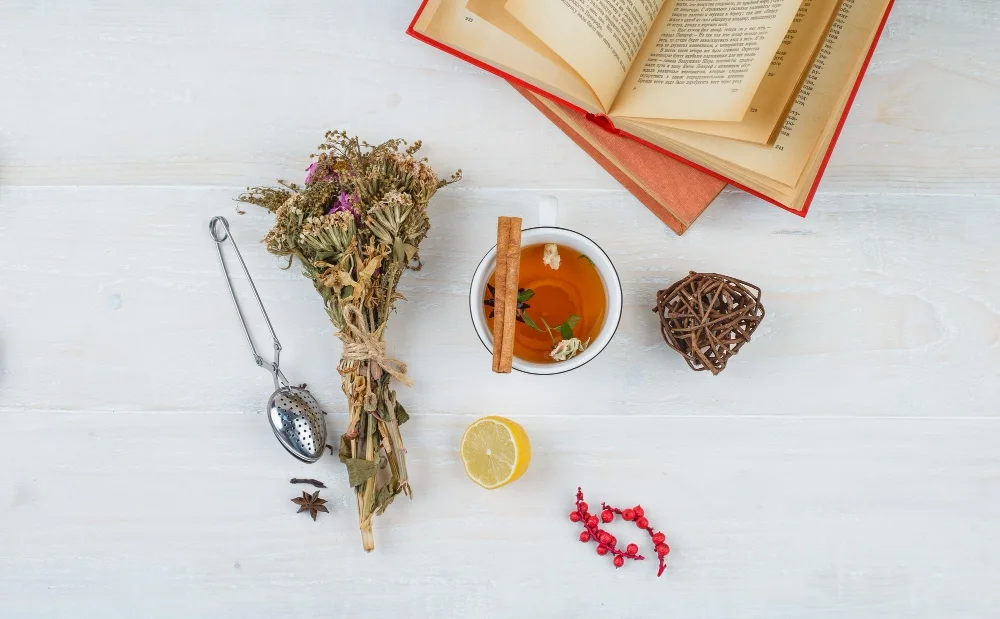In a world where wellness trends evolve at lightning speed, there’s a resounding call to return to the roots literally. Herbal infusions, once central to sacred rituals and holistic healing practices, are experiencing a modern revival. These ancient brews, once cherished in indigenous communities and spiritual traditions, are now being reintroduced with a contemporary twist. But this resurgence isn’t just about sipping tea, it's about reconnecting with nature, reviving ancestral knowledge, and embracing wellness as a deeply personal experience.
One shining example of this fusion is the goddess collection teas, which incorporate traditional herbs used in detoxifying rituals with today’s focus on immune support and energy balance. This intersection of sacred intentionality and modern wellness science is transforming how we view our daily rituals turning a simple cup of tea into something profoundly meaningful.
Key Points
-
Ancient herbal infusions are making a comeback in modern wellness spaces.
-
This revival emphasizes the blending of spiritual tradition and scientific insight.
-
Consumers are seeking clean, intentional ingredients rooted in ancestral knowledge.
-
Infusions such as adaptogenic herbs, detox teas, and ceremonial blends are gaining popularity.
-
Modern wellness products honor sacred traditions while catering to contemporary health goals.
The Origins of Sacred Infusions
For centuries, plants have been used as sacred tools in healing ceremonies, spiritual rituals, and daily nourishment. From the ayahuasca brews of the Amazon to the kava ceremonies in the South Pacific, herbal infusions were never just beverages—they were bridges between the physical and metaphysical.
Herbalism in Ancient Cultures
Indigenous cultures across Africa, Asia, and the Americas relied on a deep relationship with the Earth to guide their healing practices. Chamomile, sage, mint, and hibiscus weren’t just soothing ingredients—they were seen as plant allies imbued with spirit. These herbs were administered with prayer, song, and intention, often under the guidance of a shaman or healer.
Infusions as Medicine and Ritual
In Traditional Chinese Medicine (TCM), Ayurvedic healing, and Native American traditions, herbs served both medicinal and spiritual purposes. For example, holy basil (tulsi) in India was revered as a sacred plant, used to protect the home and balance the body. Similarly, sage was burned in North American tribes to cleanse spaces, but also brewed to treat respiratory conditions.
The Rise of Modern Wellness Trends
Fast-forward to the 21st century, and wellness has become a multi-billion-dollar industry. Yet, amid the rise of supplements and cutting-edge health tech, there's a growing hunger for something more grounded. Consumers are increasingly curious about old-world remedies that promote balance—not just in the body, but in mind and spirit.
What’s Driving the Renaissance?
-
Desire for Natural Ingredients: People are reading labels, avoiding synthetic additives, and seeking plant-based alternatives.
-
Mindfulness Movements: Meditation, yoga, and intentional living are shifting attention toward holistic care.
-
Cultural Reclamation: Many individuals are returning to their ancestral traditions, reconnecting with cultural herbs and healing methods.
-
Science Meets Tradition: Clinical studies are now validating what indigenous wisdom has known for centuries about herbs like ashwagandha, turmeric, and dandelion.
Popular Modern Infusions and Their Roots
| Modern Infusion | Traditional Origin | Wellness Benefit |
| Golden Milk (Turmeric Latte) | Ayurvedic Medicine – India | Anti-inflammatory, immune support |
| Mucus Buster Teas | Traditional Herbalism – Caribbean, Africa | Lung health, detoxification, mucosal cleansing |
| Matcha | Japanese Zen Tradition | Energy, focus, antioxidants |
| Ceremonial Cacao | Mayan and Aztec Rituals | Heart-opening, mood enhancement |
Ritual Meets Routine: How Sacred Infusions Fit into Modern Life
The beauty of this renaissance is that it invites a slower, more intentional approach to self-care. Instead of rushing through a morning coffee, more people are carving out sacred time for herbal preparations—infusing their day with mindfulness and meaning.
Creating a Daily Herbal Ritual
-
Morning: Begin with a cleansing infusion like nettle or dandelion to awaken the digestive system.
-
Afternoon: Opt for an adaptogenic blend to enhance focus and reduce stress—think tulsi, ginseng, or rhodiola.
-
Evening: Wind down with calming herbs such as chamomile, lemon balm, or passionflower.
These small acts of care accumulate, turning wellness into a lifestyle rather than a checklist.
Understanding the Herbs: Key Players in Sacred Infusions
Adaptogens
These herbs help the body adapt to stress and maintain balance. Examples include:
-
Ashwagandha: Helps with cortisol regulation and emotional resilience.
-
Rhodiola: Enhances energy and stamina during fatigue.
-
Holy Basil (Tulsi): Offers cognition support and immune boosting.
Herbs for Respiratory Health
Especially important in today’s climate, respiratory herbs support lung function and detoxification:
-
Mullein: Soothes lung tissue and clears mucus buildup.
-
Lobelia: Used in traditional Western herbalism to open airways.
-
Licorice Root: Adds soothing properties and supports adrenal health.
Herbs for Emotional Support
Many sacred infusions are also used to balance mood and emotional well-being:
-
Chamomile: Soothes anxiety and aids sleep.
-
Skullcap: Calms jittery nerves and overactive thoughts.
-
Kava: Used ritualistically for relaxation and social bonding.
What the Research Says
Modern science is slowly catching up to ancient knowledge. Several clinical studies support the efficacy of these herbs, especially when consumed consistently over time and with quality sourcing.
Scientific Endorsements
-
A 2019 study published in Phytotherapy Research showed that ashwagandha significantly reduces symptoms of stress and anxiety.
-
Research published in the Journal of Ethnopharmacology supports mullein’s effectiveness in treating respiratory issues like bronchitis and asthma.
-
Chamomile has demonstrated mild antidepressant activity in studies cited by the National Institutes of Health (NIH).
While traditional use remains the backbone of herbal medicine, ongoing research is shedding light on the biochemical mechanisms behind these age-old remedies.
Ethics and Sustainability in Sourcing
With increasing demand comes a pressing responsibility: ensuring that sacred herbs are sourced ethically and sustainably. Overharvesting, exploitation of indigenous knowledge, and ingredient adulteration are real concerns.
What to Look For
-
Certified organic or sustainably wildcrafted herbs
-
Transparent supply chains
-
Brands that honor traditional knowledge and give back to source communities
Consumers should ask: Where did this herb come from? Who grew it? Was it harvested with respect for the land and the culture it came from?
Integrating Sacred Infusions into Wellness Practices
Whether you're just starting out or deepening your herbal journey, sacred infusions offer accessible pathways to holistic health. Here’s how to incorporate them:
Starting Simple
-
Choose one or two herbs to begin with—like chamomile or tulsi.
-
Brew with intention—set your mood or goal for the tea session.
-
Keep a journal to track how your body responds to different combinations.
Going Deeper
-
Explore blending your own teas using dried herbs.
-
Experiment with hot vs. cold infusions, decoctions, and overnight soaks.
-
Attend herbal workshops or connect with community herbalists.
Frequently Asked Questions (FAQ)
What are sacred infusions?
Sacred infusions are herbal teas or beverages prepared with spiritual or ritualistic intention. They often stem from cultural or traditional healing practices and are used both for physical health and spiritual alignment.
Can anyone drink these teas?
Generally, yes—but it's important to consider individual allergies, sensitivities, and health conditions. Always consult a healthcare provider if you're taking medications or pregnant.
Are sacred infusions the same as regular teas?
No. While both are steeped herbs, sacred infusions often include ceremonial practices, ancestral herbs, and intentional brewing to enhance spiritual or emotional wellness—not just physical health.
How long should I steep sacred herbs?
It depends on the herb. Delicate herbs like chamomile need only 5–7 minutes, while roots and barks—like licorice or dandelion—may benefit from 15–30 minute decoctions or even overnight infusions.
Are there caffeine-free options?
Absolutely. Most sacred teas are caffeine-free and use herbs like tulsi, lemon balm, or hibiscus. Matcha and yerba mate are exceptions that do contain natural caffeine.
Where can I find trustworthy herbal blends?
Look for companies that prioritize ethical sourcing, transparency, and cultural respect. Collections like the goddess collection teas emphasize intentional blends rooted in traditional wisdom while addressing modern health concerns.






